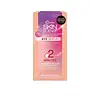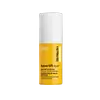What's inside
What's inside
 Key Ingredients
Key Ingredients

 Benefits
Benefits

 Concerns
Concerns

 Ingredients Side-by-side
Ingredients Side-by-side

Water
Skin ConditioningMagnesium Aluminum Silicate
AbsorbentSodium Silicate
BufferingCalcium Aluminum Borosilicate
Silica
AbrasiveS-Mu-Conotoxin Cniiic
Skin ProtectingDipeptide Diaminobutyroyl Benzylamide Diacetate
Skin ConditioningAcetyl Hexapeptide-8
HumectantCaprylyl Glycol
EmollientSynthetic Fluorphlogopite
Glycerin
HumectantPentapeptide-18
Skin ConditioningLecithin
EmollientTripeptide-10 Citrulline
Skin ConditioningCarbomer
Emulsion StabilisingPhenoxyethanol
PreservativeEthylhexylglycerin
Skin ConditioningTriethanolamine
BufferingTin Oxide
AbrasiveCI 77491
Cosmetic ColorantCI 77891
Cosmetic ColorantWater, Magnesium Aluminum Silicate, Sodium Silicate, Calcium Aluminum Borosilicate, Silica, S-Mu-Conotoxin Cniiic, Dipeptide Diaminobutyroyl Benzylamide Diacetate, Acetyl Hexapeptide-8, Caprylyl Glycol, Synthetic Fluorphlogopite, Glycerin, Pentapeptide-18, Lecithin, Tripeptide-10 Citrulline, Carbomer, Phenoxyethanol, Ethylhexylglycerin, Triethanolamine, Tin Oxide, CI 77491, CI 77891
Water
Skin ConditioningPropylene Glycol
HumectantSodium Silicate
BufferingMagnesium Aluminum Silicate
AbsorbentQuartz
AbrasiveMyristyl Nicotinate
Skin ConditioningEuterpe Oleracea Fruit Extract
Perilla Frutescens Extract
Skin ConditioningQuercus Alba Bark Extract
AstringentChondrus Crispus Extract
Skin ConditioningSodium Hyaluronate
HumectantDipeptide Diaminobutyroyl Benzylamide Diacetate
Skin ConditioningAcetyl Hexapeptide-8
HumectantAcetyl Octapeptide-3
HumectantPentapeptide-18
Skin ConditioningPalmitoyl Tripeptide-1
Skin ConditioningPalmitoyl Tetrapeptide-7
Skin ConditioningLactobacillus Ferment
Skin ConditioningIllite
AbrasiveMontmorillonite
AbsorbentCellulose Gum
Emulsion StabilisingGlycerin
HumectantButylene Glycol
HumectantCaprylyl Glycol
EmollientCarbomer
Emulsion StabilisingPolysorbate 20
EmulsifyingSodium Dehydroacetate
PreservativeCitric Acid
BufferingChlorphenesin
AntimicrobialSorbic Acid
PreservativePotassium Sorbate
PreservativePhenoxyethanol
PreservativeEthylhexylglycerin
Skin ConditioningCI 77491
Cosmetic ColorantWater, Propylene Glycol, Sodium Silicate, Magnesium Aluminum Silicate, Quartz, Myristyl Nicotinate, Euterpe Oleracea Fruit Extract, Perilla Frutescens Extract, Quercus Alba Bark Extract, Chondrus Crispus Extract, Sodium Hyaluronate, Dipeptide Diaminobutyroyl Benzylamide Diacetate, Acetyl Hexapeptide-8, Acetyl Octapeptide-3, Pentapeptide-18, Palmitoyl Tripeptide-1, Palmitoyl Tetrapeptide-7, Lactobacillus Ferment, Illite, Montmorillonite, Cellulose Gum, Glycerin, Butylene Glycol, Caprylyl Glycol, Carbomer, Polysorbate 20, Sodium Dehydroacetate, Citric Acid, Chlorphenesin, Sorbic Acid, Potassium Sorbate, Phenoxyethanol, Ethylhexylglycerin, CI 77491
Ingredients Explained
These ingredients are found in both products.
Ingredients higher up in an ingredient list are typically present in a larger amount.
Acetyl Hexapeptide-8, commonly known as Argireline or Acetyl Hexapeptide-3, is a popular peptide in skincare. It’s often referred to as a “Botox-like” ingredient because it helps reduce muscle movement.
By relaxing these micro-movements, Argireline may help minimize the appearance of fine lines and wrinkles. That said, it’s not as powerful as Botox, and research on its long-term effectiveness is still limited.
Beyond smoothing, Argireline may also support collagen production. Collagen is the protein that helps keep your skin firm, bouncy, and well-hydrated by strengthening the skin barrier.
So while Argireline isn’t a miracle fix, it can be a helpful addition to a routine focused on both prevention and skin health.
Read more about other common types of peptides here:
Learn more about Acetyl Hexapeptide-8Caprylyl Glycol is a humectant and emollient, meaning it attracts and preserves moisture.
It is a common ingredient in many products, especially those designed to hydrate skin. The primary benefits are retaining moisture, skin softening, and promoting a healthy skin barrier.
Though Caprylyl Glycol is an alcohol derived from fatty acids, it is not the kind that can dry out skin.
This ingredient is also used as a preservative to extend the life of products. It has slight antimicrobial properties.
Learn more about Caprylyl GlycolCarbomer is a polymer of acrylic acid. Its main role is to create a gel consistency.
A high amount of carbomer can cause pilling or balling up of products. Don't worry, most products contain 1% or less of carbomer.
Ci 77491 is also hydrated iron III oxide. It's sole purpose is to give a red/pink hue to products.
Iron III oxides are classified as inorganic chemicals for coloring.
Synthetically created Ci 77491 is considered safer than those naturally found. This is because the synthetically created version may contain less impurities. Iron oxides are generally non-toxic and non-allergenic.
Learn more about CI 77491This small molecule peptide has similar benefits to Argireline, the "botox" peptide.
According to the manufacturer, this peptide mimics snake venom to freeze muscles. This prevents muscle movement and contractions to prohibit the formation of fine lines and wrinkles.
While this seems promising, research is lacking in proving this ingredient to be as effective as botox.
Learn more about Dipeptide Diaminobutyroyl Benzylamide DiacetateEthylhexylglycerin (we can't pronounce this either) is commonly used as a preservative and skin softener. It is derived from glyceryl.
You might see Ethylhexylglycerin often paired with other preservatives such as phenoxyethanol. Ethylhexylglycerin has been found to increase the effectiveness of these other preservatives.
Glycerin is already naturally found in your skin. It helps moisturize and protect your skin.
A study from 2016 found glycerin to be more effective as a humectant than AHAs and hyaluronic acid.
As a humectant, it helps the skin stay hydrated by pulling moisture to your skin. The low molecular weight of glycerin allows it to pull moisture into the deeper layers of your skin.
Hydrated skin improves your skin barrier; Your skin barrier helps protect against irritants and bacteria.
Glycerin has also been found to have antimicrobial and antiviral properties. Due to these properties, glycerin is often used in wound and burn treatments.
In cosmetics, glycerin is usually derived from plants such as soybean or palm. However, it can also be sourced from animals, such as tallow or animal fat.
This ingredient is organic, colorless, odorless, and non-toxic.
Glycerin is the name for this ingredient in American English. British English uses Glycerol/Glycerine.
Learn more about GlycerinMagnesium Aluminum Silicate is a type of silica. It comes from naturally occuring minerals such as silicate ores and clay.
Magnesium aluminum silicate is used for enhancing texture and as an absorbent. Due to its large molecular size, it is unable to be absorbed into the skin.
Like other types of silica, this ingredient can be used to thicken a product. As an absorbent, it may be used to absorb extra water or help prevent clumping.
Although “aluminum” in an ingredient name can raise red flags for some consumers, the form and usage context matter significantly. For typical topical applications, there is no substantial evidence of health risks - such as cancer, neurotoxicity, or systemic “aluminum overload.”
Learn more about Magnesium Aluminum SilicateThis peptide is more commonly known as Leuphasyl. It has similar properties to argireline, the "botox peptide".
According to a manufacturer, Pentapeptide-18 mimics botulinum to freeze muscles and reduce the appearance of wrinkles. Their study found this 5% of this ingredient reduced wrinkles by 11%.
Combining this ingredient with Argireline showed improved results.
Learn more about Pentapeptide-18Phenoxyethanol is a preservative that has germicide, antimicrobial, and aromatic properties. Studies show that phenoxyethanol can prevent microbial growth. By itself, it has a scent that is similar to that of a rose.
It's often used in formulations along with Caprylyl Glycol to preserve the shelf life of products.
We don't have a description for Sodium Silicate yet.
Water. It's the most common cosmetic ingredient of all. You'll usually see it at the top of ingredient lists, meaning that it makes up the largest part of the product.
So why is it so popular? Water most often acts as a solvent - this means that it helps dissolve other ingredients into the formulation.
You'll also recognize water as that liquid we all need to stay alive. If you see this, drink a glass of water. Stay hydrated!
Learn more about Water